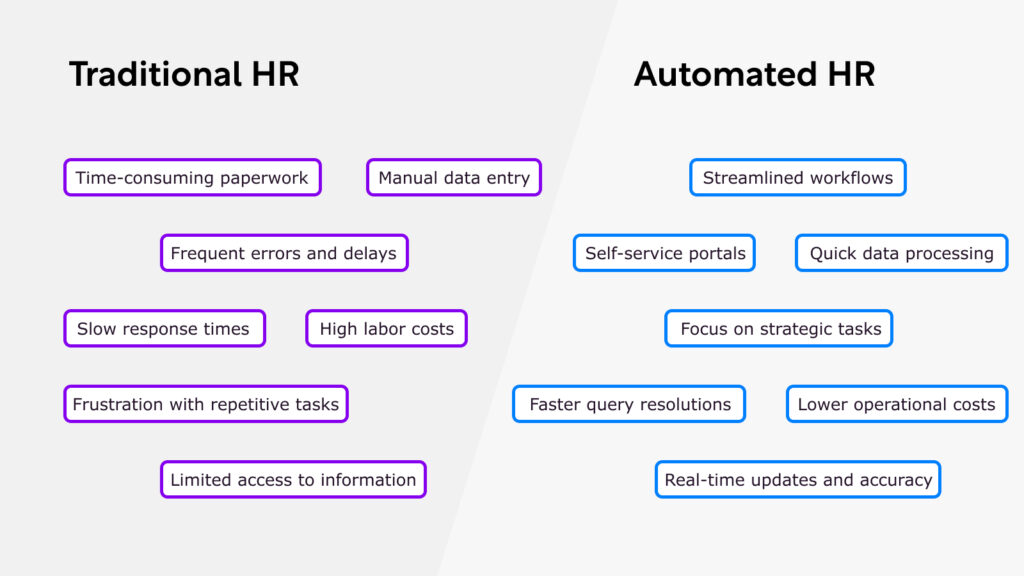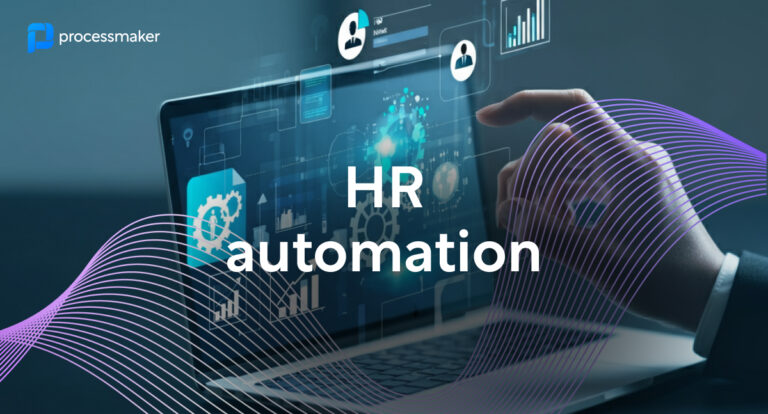Human Resources (HR) departments are the backbone of any organization, responsible for managing people, the company’s most valuable asset. However, HR tasks often involve repetitive and time-consuming processes. This is where HR automation steps in to revolutionize the landscape.
HR automation refers to the use of technology to streamline and automate HR processes, removing manual effort from administrative tasks to focus on strategic decision-making.
With the increasing adoption of HR automation software, such as business process automation (BPA) platforms, HR professionals are now better equipped to solve challenges, save time, and enhance employee satisfaction. The relevance of HR automation has never been greater, as organizations face growing demands for efficiency in a fast-paced, digital-first world.
When to implement HR automation?
How do you know that automation for HR is the next best initiative for your organization?
One clear indicator is the prevalence of repetitive and time-consuming HR tasks, such as manual data entry or benefits administration, which bog down the department’s productivity.
If your organization is growing and increasing in operational complexity, that could be the next sign to improve efficiency and accuracy through automation.
Additionally, organizations aiming to enhance the employee experience—by offering better communication tools, faster onboarding, or real-time feedback systems—are great candidates for HR automation.
Finally, readiness is also reflected in having a leadership team that supports innovation, a well-defined strategy for implementation, and a willingness to invest in the right tools, technology, and employee training. These elements together ensure a seamless adoption of HR automation to meet evolving organizational needs.

Key areas of HR automation
Automation has transformed several key HR functions, streamlining tasks and providing significant gains in efficiency. Here are four areas where automation for HR processes makes a noticeable impact.
Recruitment
HR process automation significantly enhances the recruitment process by streamlining time-intensive activities such as resume screening, interview scheduling, and candidate communication. By leveraging automation tools, HR teams can process large volumes of applications with greater efficiency, ensuring that top talent is identified quickly.
Automated workflows reduce human error and administrative burden, allowing HR professionals to focus on strategic tasks like candidate engagement and relationship building. Additionally, automation improves the candidate experience by providing timely updates and personalized interactions, fostering a positive impression of the organization.
With advanced data management capabilities, HR teams can also gain valuable insights from recruitment analytics, enabling better decision-making and more effective hiring strategies.
Recruitment processes that can benefit from a BPA platform include tasks such as:
- Job posting and advertising
- Resume screening
- Interview scheduling
- Candidate communication
- Data management and reporting
Payroll and benefits
HR process automation in payroll and benefits administration brings significant advantages to organizations. By automating these time-intensive tasks, HR teams can save substantial effort and ensure more efficient operations.
Payroll automation reduces errors in calculations, streamlines tax compliance, and guarantees timely salary disbursement, minimizing the risk of delays or discrepancies. Similarly, automated benefits administration simplifies employee enrollment and updates, allowing teams to manage programs effortlessly while maintaining accuracy in records.
This enhanced efficiency not only saves HR professionals from repetitive administrative duties but also contributes to improved employee satisfaction. Automation empowers HR to focus on higher-value tasks like strategy and talent development while creating a seamless experience for the workforce.
Payroll processes that can be automated include tasks such as:
- Payroll calculations
- Tax deductions
- Compliance reporting
- Benefits enrollment
Onboarding and offboarding of employees
During onboarding, automation can handle tasks such as generating offer letters, digitizing paperwork, setting up IT accounts, and scheduling orientation sessions through pre-configured workflows. This reduces manual errors and ensures a smoother, faster integration of new employees into the organization.
Similarly, during offboarding, automation can manage processes like exit interviews, revoking system access, and processing final payrolls seamlessly. These automated workflows not only save HR teams significant time and effort but also ensure compliance with organizational policies while creating a professional and structured experience for departing employees.
By reducing administrative burden, HR can focus on strategic initiatives, fostering a more productive and engaged workplace.
Onboarding and offboarding process include:
- Generating and sending offer letters
- Collecting and processing new hire documentation
- Setting up IT accounts
- Scheduling orientation and training sessions
- Conducting exit interviews
- Revoking system access and retrieving company assets
- Processing final payroll
Employee engagement and communication
With automation tools such as chatbots and dedicated communication platforms, HR departments can facilitate seamless and instant interaction, ensuring employees’ questions are addressed promptly and accurately at any time.
Real-time feedback mechanisms, like automated surveys and pulse checks, allow HR teams to gauge employee sentiments, identify areas of improvement, and take actionable steps to boost morale. These tools not only streamline the flow of information within the organization but also empower employees by making resources and support easily accessible.
By reducing delays and improving transparency, HR automation fosters a sense of trust and inclusivity, contributing to a more positive and engaged company culture.
Benefits of HR automation
The adoption of HR automation brings considerable advantages that contribute to efficiency and organizational success. Here are some key benefits:
- Cost reduction
By automating time-intensive processes, organizations can reduce SaaS subscription costs as well as labor costs. For example, a chatbot answering routine HR questions can save countless hours of manual intervention, and a single BPA platform can eliminate the need for countless separate SaaS tools.
- Increased efficiency and productivity
Automation removes manual bottlenecks, enabling HR staff to focus on strategic responsibilities. It reduces redundant tasks and shortens process timelines, leaving more bandwidth for creativity and innovation.
- Improved accuracy and compliance
Manual tasks can often lead to errors, especially in payroll and compliance reporting. Automation ensures accurate calculations, reduces risks of non-compliance, and maintains records efficiently, which is especially critical for audits.
- Enhanced employee experience
Automation improves the employee experience by streamlining workflows, making processes transparent, and ensuring quicker responses to employee concerns. Easy access to HR services fosters a sense of empowerment and trust among employees.
Challenges in HR automation
- Implementation
Rolling out new automation tools can be costly and time-intensive. Many projects like RPA roll-out or specialized software by a consulting firm may take months to years to build and deploy. Apart from that, there are also integration challenges with existing systems.
However, BPA platforms like ProcessMaker are changing the automation game by providing a low-code platform that allows even non-technical users design workflows and automate their organizational processes.
- Data security
Automated HR systems often handle sensitive employee data. Strong measures must be in place to ensure information is protected from breaches or unauthorized access. The software should also be compliant with privacy and security standards like SOC and GDPR.
- Change management
Transitioning to an automated HR system requires both employees and HR professionals to adapt. Resistance to change and lack of training can hinder success, making effective change management crucial.
Case studies and examples
ProcessMaker has significantly transformed Adecco Colombia’s automation landscape by streamlining and automating core service operations. Before implementing ProcessMaker, Adecco staff supported its temporary employees through manual, ad-hoc email chains. It led to inefficiencies and errors, particularly in managing support tickets and employee permissions. The lack of systematized workflows resulted in unresolved tickets and inconsistent data handling.
By adopting ProcessMaker, Adecco Colombia automated over 30 processes, including vacation requests and customer support workflows, integrating seamlessly with their existing ERP system. This automation has enabled real-time, transparent, and secure process management, reducing manual data entry and errors.
Employees now receive timely access to necessary tools and information, enhancing their performance and ensuring optimal resource allocation. The automation of these processes has not only improved efficiency but also enhanced the overall employee and customer experience, positioning Adecco Colombia as a forerunner in HR process automation.
Future trends in HR automation
The future of HR automation is promising, with advancements in AI and other technologies continuing to reshape the field. Here’s a sneak peek into what lies ahead:
- AI and Machine Learning in HR
AI will advance applications such as predictive hiring, skills gap analysis, and workforce analytics. Moreover, Agentic AI will change the way HR teams operate, automating the entire end-to-end workfollows, and serving almost like an independent member of the team.
- The role of chatbots and virtual assistants
Chatbots will evolve to handle more complex HR interactions, ranging from resolving employee disputes to conducting exit interviews. Their 24/7 availability makes them a critical component of HR automation strategies. Many BPA platforms have chatbot functionality embedded in them.
- Predictive analytics
Predictive analytics will enable HR teams to foresee workforce trends, anticipate employee turnover, and plan for skills shortages. This data-driven approach ensures more proactive and informed decision-making.
Start your HR automation journey today
Business process automation, including that of the HR department, is a necessity in today’s fast-paced, dynamic workplace. By leveraging BPA platforms like ProcessMaker, HR teams can transform their processes to be more efficient, transparent, and employee-centric. From streamlining repetitive tasks to enhancing communication and engagement, automation empowers HR teams to focus on what truly matters—creating a thriving and motivated workforce.
ProcessMaker stands out as a game-changer in this field, offering the ability to design custom workflows without the need for technical expertise. This ease of use ensures that HR teams can quickly adapt to changing organizational demands, enhance decision-making through process intelligence, and unlock the full potential of their workforce.





